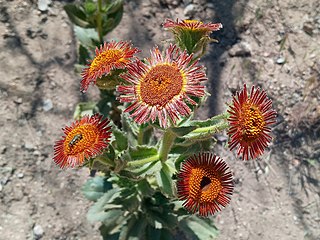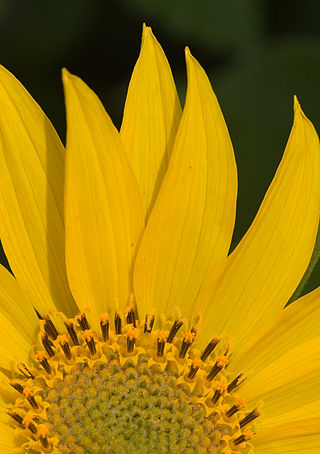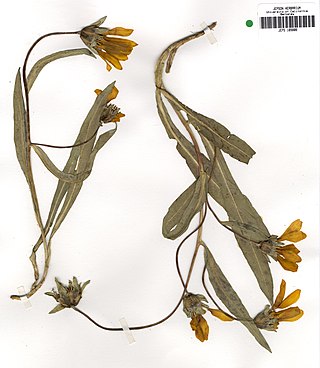
Hulsea heterochroma, commonly known as redray alpinegold, is a species of flowering plant in the family Asteraceae.
Layia septentrionalis is an uncommon species of flowering plant in the family Asteraceae known by the common name Colusa tidytips, or Colusa layia.

Chaenactis artemisiifolia, with the common name white pincushion, is a species of flowering plant in the daisy family. It is native to the coastal Peninsular Ranges of Southern California and Baja California, in the chaparral and woodlands.

Ageratina herbacea is a North American species of flowering plants in the family Asteraceae known by the common names fragrant snakeroot and Apache snakeroot. It is native to desert regions of the southwestern United States and northern Mexico. It grows in rocky slopes in conifer forests and woodlands.

Arnica nevadensis is a North American species of arnica in the sunflower family, known by the common names Nevada arnica and Sierra arnica. It is native to the coniferous forests of the western United States, primarily the Cascades and Sierra Nevada.

Arnica venosa is a rare California species of flowering plant in the family Asteraceae known by the common name Shasta County arnica. It should not be confused with the Mt. Shasta arnica, A. viscosa.

Balsamorhiza deltoidea is a species of flowering plant in the sunflower tribe of the plant family Asteraceae known by the common name deltoid balsamroot. It is native to western North America from British Columbia to California, where it grows in many types of generally mountainous habitat.
Calycadenia mollis is a species of flowering plant in the family Asteraceae known by the common name soft western rosinweed. It is native to a section of central California, from Tuolumne County do northern Tulare County. There are also isolated populations farther north in Nevada County. The plant grows in a number of habitat types in the Central Valley and adjacent Sierra Nevada foothills.

Calycadenia multiglandulosa is a species of flowering plant in the family Asteraceae, known by the common names sticky calycadenia and sticky western rosinweed. It is endemic to California, where it is a common in the Coast Ranges and in the Sierra Nevada Foothills from Shasta County to Kern County.
Calycadenia pauciflora is a species of flowering plant in the family Asteraceae known by the common name smallflower western rosinweed. It is endemic to northern California, where it grows in the Coast Ranges north of the San Francisco Bay Area from Napa County to Tehama County, often on serpentine soils.

Chaenactis suffrutescens is a species of flowering plant in the aster family known by the common name Shasta chaenactis.

Hieracium argutum is a species of flowering plant in the family Asteraceae known by the common name southern hawkweed.

Perityle inyoensis, known by the common names Inyo rockdaisy and Inyo laphamia, is a rare species of flowering plant in the aster family.

Arnica dealbata is a species of Californian plants in the tarweed tribe within the aster family

Agnorhiza bolanderi is a species of flowering plant known by the common name Bolander's mule's ears. It is endemic to California, where it is known only from a narrow section of the Sierra Nevada foothills about 275 kilometers long from Shasta County to Mariposa County. It grows in chaparral and grassland habitat, usually on serpentine soils.

Wyethia glabra is a species of flowering plant in the family Asteraceae known by the common name Coast Range mule's ears. It is endemic to California, where it grows in the North and Central Coast Ranges. It is a perennial herb growing from a tough taproot and caudex unit and producing a stem up to 40 centimeters tall. It is hairless to hairy and glandular. The leaves have lance-shaped or oval blades up to 45 centimeters long. The inflorescence is usually a solitary flower head or occasionally a cluster of 2 or more. The head has lance-shaped leaflike phyllaries at the base. It contains up to 21 yellow ray florets each up to 5 centimeters long and many yellow disc florets. The fruit is an achene over a centimeter long, including its pappus.

Wyethia longicaulis is a species of flowering plant in the family Asteraceae known by the common name Humboldt mule's ears. It is endemic to California, where it occurs in the North Coast Ranges and the Klamath Mountains. It grows in mountain and foothill habitat such as grassland and forests. It is a perennial herb growing from a tough taproot and caudex unit and producing a stem up to half a meter tall. It is hairless to hairy and glandular. The leaves have lance-shaped or oblong blades up to 20 centimeters long. They are glandular and have a waxy exudate that dries white. The inflorescence is usually a cluster of 2 to 4 flower heads, each with up to 10 yellow ray florets which may be up to 3 centimeters long. The fruit is an achene about a centimeter long, including its tiny pappus.

Agnorhiza ovata is a species of flowering plant known by the common name southern mule's ears. It is native to the mountains and foothills of southern California and Baja California, occurring the Coast Ranges and Sierra Nevada foothills in Tulare, Kern, Ventura, Los Angeles, Orange, Riverside, and San Diego counties in California, with additional populations in the Peninsular Ranges south of the international border.

Deinandra mohavensis, commonly known as Mojave tarplant or Mojave tarweed, is a species of flowering plant in the family Asteraceae.

Hymenothrix wrightii, commonly known as Wright's hymenothrix or Wright's thimblehead, is a North American species of flowering plant in the daisy family. It grows in northwestern Mexico and the southwestern United States.


















